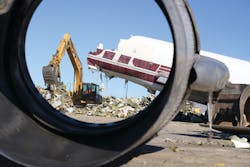Aircraft builders and assemblers must have a tremendous sense of personal satisfaction, and rightly so. To watch new aircraft roll out of the paint hangar knowing that it will have a 20- to 30-year service life is cause for celebration. Today aircraft manufacturing is accelerating and the numbers and kinds of aircraft being produced are amazing. But, what happens to these aircraft when they lose their economic value, or reach the end of their service life? Many are transferred to locations in Tucson, AZ; Victorville, CA; and Roswell, NM, where some are temporarily parked awaiting recall to service and others are demolished and recycled.
Aircraft recycling is going “green” and appears to be a growth industry. Some manufacturers, owners, and operators are assuming end to end responsibility for their products and want to mitigate their environmental impact by re-claiming serviceable components and scarce materials. They and other concerned professionals formed an association to further their goal of environmental stewardship and product responsibility.
The Aircraft Fleet Recycling Association (AFRA)
AFRA is an international nonprofit association that “promotes environmental best practices, regulatory excellence, and sustainable developments in the fields of aircraft disassembly, salvaging, and recycling aircraft parts and materials. AFRA was founded in 2005 when 11 companies joined forces to develop an industry code of conduct and a set of best practices for dismantling and recycling aircraft materials. Today AFRA has 40 members from 10 countries including OEMs, aircraft dissemblers, parts distributors, aircraft insurers and appraisers, materials recyclers, and technology developers.
AFRA also provides members with an accreditation process and its best management practice guides. The accreditation lets potential customers know that a certified company is following best management and environmentally responsible processes to manage the end-of-life disassembly and disposable of airframes and engines.
According to AFRA, “About 12,500 aircraft will reach their end-of-life in the next 20 years. The disposal of these aircraft is why many aviation companies have launched environmental programs to address this problem. To date, AFRA members have dismantled more than 9,000 aircraft, with 7,000 from the commercial sector and 2,000 from the military.” One of the accredited companies is Aircraft Demolition located in Burnsville, MN. It is a leader in this industry and the only company that has the disassembly of aircraft, powerplants, and other aerospace materials and the recycling of aerospace materials certifications from the Aircraft Fleet Recycling Association (AFRA).
Aircraft Demolition
Aircraft Demolition was founded by Tim Zemanovic in 2008. He is the quintessential hard-working Midwestern businessman. He is also an A&P technician with more than 25 years of maintenance experience with AAR Inc., United, and Northwest Airlines. His favorite specialty was heavy structural repair.
One of the things that concerned him during his career at the airlines was the lack of their recycling efforts. He feels that being environmentally responsible and taking a “green” approach to business is both practical and profitable. This philosophy is evident throughout his demolition business practices. His successful entry into the aircraft demolition and recycling business resulted from a relative with a nonferrous recycling business who told him that he needed some new sources of nonferrous materials. Zemanovic contacted some acquaintances at the airlines and soon Aircraft Demolition was in operation.
According to Zemanovic, most other recycling companies are staffed by people from the recycling industry (“scrappers”) and lack the aviation technical expertise. His extensive experience in the majors helped him develop a business model similar to a traditional aviation company. They have facility audits and training programs, follow AFRA best practices, and keep abundant documentation. Rather than being certified like a typical ISO 1400 company, the company is certified by AFRA. Aircraft Demolition employs 11 A&Ps that have on average 20 years of aviation experience; a competitive advantage in the aircraft disassembly business.
Zemanovic and his crew follow a continuous improvement philosophy and perform careful analysis and keep detailed records about the aircraft and engines that they part out, demolish, and recycle. They currently meet the AFRA standards and recycle up to 90 to 92 percent of an airframe and 99 percent of jet engines. Recyclers like Zemanovic feel that an even higher rate can be achieved when materials that are used in aircraft interiors and furnishing can be disposed of safely and at a profit. According to press releases many major OEMs, researchers, and recyclers are working on this challenging problem.
Aircraft Demolition’s processes are proprietary, however a typical demolition job would include preparing the aircraft by removing serviceable parts, stripping out wiring, hazardous materials, and fluids. Next they crush the fuselage and haul it away to be shredded and recycled. They can do this at any work site with a few AMTs and in an amazingly short amount of time.
According to Zemanovic, “We can demolish a B737 size aircraft in hours and a B747 size aircraft in a few days including total cleanup to prevent any potential foreign object damage.” Part removal and identification for resale requires additional time. They can perform their services for any customer in any location from Saudi Arabia to Victorville, CA. Most of their jobs are in the Southwest around the major aircraft storage facilities.
Aircraft Demolition also buys and recycles military and civilian aircraft engines that are delivered to the secure Burnsville, MN, facilities for teardown. Some of the engines recycled are PW F100, PW JT8D, GE J79, and larger engines like Rolls-Royce RB211 jet engines.
According to Zemanovic, “Our aviation experience improves our engine recycling efficiency and profitability as well. It takes our experienced crews about four days to disassemble these large engines and segregate the valuable components and materials.” The Aircraft Demolition crew uses a highly sophisticated handheld (X-ray) instrument to identify metal composition including precious metals.
We know that AMTs enjoy building and assembling shiny new aircraft. I wanted to know how Aircraft Demolition’s crew felt about disassembling, demolishing, and recycling aircraft. Zemanovic says, “We love our work and feel great about what we do. Aircraft Demolition is filling an important business need, creating jobs, reducing our environmental impact, and returning valuable resources to the market. The United States has more out-of-service aircraft than any other country. Many are leased aircraft and owners and operators are paying storages fees year after year. Many of these aircraft will never fly again. We can recycle these aircraft and put the materials back in the market cheaper and with a smaller environmental impact than mining and processing new materials. Because Aircraft Demolition is AFRA accredited, owners can be assured parts and accessories are kept off the black market. Just five years ago, we started at 68 percent recyclability and have been steadily rising toward our goal of 95 percent. We love recycling and hope one day to achieve 100 percent recycling with airframes.”
New perspective on aging aircraft
In the recent past the term “aging aircraft” was commonly defined by calendar years and operating hours. In the current economic climate, aircraft age also has a direct correlation to the economic value of the aircraft. Investors, aircraft leasers, owners, and operators are using sophisticated models to analyze the relative value of an aircraft. They must calculate debt and equity ratios and determine the current and depreciating value of an aircraft.
In a recent press release from Aviation Fleet Management, editor Mary-Anne Baldwin stated, “This subject of aircraft depreciation is perhaps more relevant now than ever. Aircraft retirement age is dropping as Next Gen aircraft enter the market. The typical depreciation period is 25 years; however, most aircraft do not fly for that long. Indeed, it is now typical for low-cost airlines to run a fleet with an average age of five years.”
Additionally, in an International Bureau of Aviation press release, experts suggested that “several factors have come into play with regards to aircraft economic life recently. There is an increasing trend toward operating leases that allow the lessees to return aircraft long before their economic life expires. More aircraft are being parted out for spares at a young age – a few as early as two years old and more in the five- to 10-year age range have been seen recently.” It appears that the service life of our aircraft is being shortened at an accelerating pace and for a variety of reasons.
The cycle continues
Our space and aviation industry has a huge environmental impact and carbon footprint. It is our companies and our individual responsibility to ameliorate that impact and reduce our carbon footprint through the life cycle of our aircraft. It is gratifying to know that organizations like AFRA are helping define standards and best practices for aircraft end-of-life events. Major OEMs are being recognized as responsible end-to-end product managers, and companies like Aircraft Demolition are processing aging and out-of-service aircraft. They harvest the serviceable parts and components, process e-waste and return valuable American strategic resources to the supply chain. As AMTs, our challenge will be to adapt to the rate of change in our industry and to find that elusive job satisfaction. Whether it is at the leading edge of aviation manufacturing and technology or in the recycling yard, the possibilities are endless.
For more information on Aircraft Demolition call (952) 224-2424 or visit www.aircraftdemolition.com. For more information on Aircraf Fleet Recycling Association visit www.afraassociation.org or call (202) 347-6899.
Charles Chandler began his aviation career as a junior mechanic for American Airlines and retired after 27 years of service. He has a Master's of Science degree in adult and occupational education with a major in human resources development.




